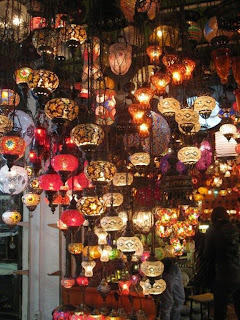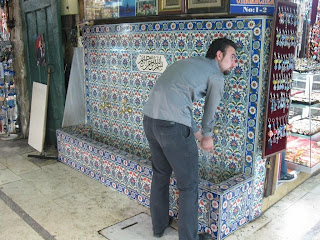First, we walked. Despite what the Dutch would have you believe, tulips were invented in Turkey. The city was awash with them while we were there.

Like all self-respecting major cities, it has an Egyptian obelisk. Why not?
 It also has a series of quite enormous and profoundly impressive mosques. This is the Blue Mosque, about 50m from our hotel, as was just about everything else for that matter. It was referred to by a young Australian guy we met on the Gallipoli trip, rather refreshingly, as "a big f#@k off mosque", which is undeniable.
It also has a series of quite enormous and profoundly impressive mosques. This is the Blue Mosque, about 50m from our hotel, as was just about everything else for that matter. It was referred to by a young Australian guy we met on the Gallipoli trip, rather refreshingly, as "a big f#@k off mosque", which is undeniable. Inside are the usual reminders of the greatness of Allah, but beneath those painted patterns is plaster, and beneath the plaster is the artwork of the previous cathedral, consisting largely of icons which are forbidden by Islam.
Inside are the usual reminders of the greatness of Allah, but beneath those painted patterns is plaster, and beneath the plaster is the artwork of the previous cathedral, consisting largely of icons which are forbidden by Islam.
Now that it is a museum, however, the more attractive icons can be seen and books thereof purchased.
 We also went to the Sultan's palace. It had some amazing stuff, like King David's sword, Mohammed's bow and arrow, four pieces of Mohammed's beard, the footprint of Mohammed (mud), daggars with precious stones the size of golf balls, and various other bits of Mohammed and his followers.
We also went to the Sultan's palace. It had some amazing stuff, like King David's sword, Mohammed's bow and arrow, four pieces of Mohammed's beard, the footprint of Mohammed (mud), daggars with precious stones the size of golf balls, and various other bits of Mohammed and his followers.  And here the royal crapper.
And here the royal crapper.
 There are rooms and rooms of beautiful tiles and art. Here is just one example.
There are rooms and rooms of beautiful tiles and art. Here is just one example.
 This is the Beyoglu district if Istanbul, only a moderate walk from where we were staying. At the top of the hill is a Parisian style cluster of restaurants and stores, some of the best we have ever seen. As in Dubai, we were the obvious poor trolls who did not belong there. Security guards tailed us in the shops, watching as our grubby little fingers ruined their merchandise.
This is the Beyoglu district if Istanbul, only a moderate walk from where we were staying. At the top of the hill is a Parisian style cluster of restaurants and stores, some of the best we have ever seen. As in Dubai, we were the obvious poor trolls who did not belong there. Security guards tailed us in the shops, watching as our grubby little fingers ruined their merchandise.
 The area also has rows and rows of cafes catering to the Turkish obsession with sugar. You can buy sweets that are essentially 20cm long cylinders of sugar. Big burly men eat them on wharfs, although unlike Syrians (who Turks tend to laugh at whenever they are mentioned), the wharfies don't hold hands and sing pop ballads.
The area also has rows and rows of cafes catering to the Turkish obsession with sugar. You can buy sweets that are essentially 20cm long cylinders of sugar. Big burly men eat them on wharfs, although unlike Syrians (who Turks tend to laugh at whenever they are mentioned), the wharfies don't hold hands and sing pop ballads.
 We also went to the Sultan's palace. It had some amazing stuff, like King David's sword, Mohammed's bow and arrow, four pieces of Mohammed's beard, the footprint of Mohammed (mud), daggars with precious stones the size of golf balls, and various other bits of Mohammed and his followers.
We also went to the Sultan's palace. It had some amazing stuff, like King David's sword, Mohammed's bow and arrow, four pieces of Mohammed's beard, the footprint of Mohammed (mud), daggars with precious stones the size of golf balls, and various other bits of Mohammed and his followers.The palace is one of the reasons Turkey got into the First World War. Building it nearly bankrupted the empire, but great empires need battleships, but the money had been spent on tiles and gemstones, and commanderring various bits of Mohammed. The UK would not supply the battleships (although it took the Ottomans' money for them) but the Germans would, and the deaths of 250,000 Turks at Gallipoli are just a few short political steps away. If the Allied attack on the Dardanelles were successful, the British fleet would have made light work of the palace, so failure was not an option for the Turks.
Here is a bath in the palace. It would not have been pleasant in the Turkish winter.
 And here the royal crapper.
And here the royal crapper.  There are rooms and rooms of beautiful tiles and art. Here is just one example.
There are rooms and rooms of beautiful tiles and art. Here is just one example. This is the Beyoglu district if Istanbul, only a moderate walk from where we were staying. At the top of the hill is a Parisian style cluster of restaurants and stores, some of the best we have ever seen. As in Dubai, we were the obvious poor trolls who did not belong there. Security guards tailed us in the shops, watching as our grubby little fingers ruined their merchandise.
This is the Beyoglu district if Istanbul, only a moderate walk from where we were staying. At the top of the hill is a Parisian style cluster of restaurants and stores, some of the best we have ever seen. As in Dubai, we were the obvious poor trolls who did not belong there. Security guards tailed us in the shops, watching as our grubby little fingers ruined their merchandise.  The area also has rows and rows of cafes catering to the Turkish obsession with sugar. You can buy sweets that are essentially 20cm long cylinders of sugar. Big burly men eat them on wharfs, although unlike Syrians (who Turks tend to laugh at whenever they are mentioned), the wharfies don't hold hands and sing pop ballads.
The area also has rows and rows of cafes catering to the Turkish obsession with sugar. You can buy sweets that are essentially 20cm long cylinders of sugar. Big burly men eat them on wharfs, although unlike Syrians (who Turks tend to laugh at whenever they are mentioned), the wharfies don't hold hands and sing pop ballads. We opted for profiteroles drowned in chocolate.
 These are the reserve elements of the profiterole army.
These are the reserve elements of the profiterole army.
 These are the reserve elements of the profiterole army.
These are the reserve elements of the profiterole army.We thought we had seen it all, but just metres from Aya Sofia and underneath a bunch of office buildings is this, a Byzantine underground reservoir, 143m x about 90m. That is bloody huge, by the way. We were expecting a largish well. The roof leaks a bit but that can be forgiven after 1,500 years.


A couple of the colums are supported by inverted heads of Medusa, and no one quite knows why. This just adds to the intrigue of the place.
And we finished off our visit with some time in the Grand Bazaar.
 You want it, they have it. T-shirts picturing beastiality, M-16's with telescopic sights, 1936 Vacheron Constantin watches (that may or may not work), fashionable and elegant fake Prada bags sold by big guys with bigger mullets, snow globes of the Taj Mahal just in case, the usual array of swords and lingerie shops, and glass light fittings - Westfield but catering more to the young male lager lout market.
You want it, they have it. T-shirts picturing beastiality, M-16's with telescopic sights, 1936 Vacheron Constantin watches (that may or may not work), fashionable and elegant fake Prada bags sold by big guys with bigger mullets, snow globes of the Taj Mahal just in case, the usual array of swords and lingerie shops, and glass light fittings - Westfield but catering more to the young male lager lout market.
 And, like everything in Istanbul, within leisurely walking distance and with questionable kebabs in all directions.
And, like everything in Istanbul, within leisurely walking distance and with questionable kebabs in all directions.
 You want it, they have it. T-shirts picturing beastiality, M-16's with telescopic sights, 1936 Vacheron Constantin watches (that may or may not work), fashionable and elegant fake Prada bags sold by big guys with bigger mullets, snow globes of the Taj Mahal just in case, the usual array of swords and lingerie shops, and glass light fittings - Westfield but catering more to the young male lager lout market.
You want it, they have it. T-shirts picturing beastiality, M-16's with telescopic sights, 1936 Vacheron Constantin watches (that may or may not work), fashionable and elegant fake Prada bags sold by big guys with bigger mullets, snow globes of the Taj Mahal just in case, the usual array of swords and lingerie shops, and glass light fittings - Westfield but catering more to the young male lager lout market. And, like everything in Istanbul, within leisurely walking distance and with questionable kebabs in all directions.
And, like everything in Istanbul, within leisurely walking distance and with questionable kebabs in all directions.When you sell that sort of gear, some forgiveness from above is needed, and ablution bays are conveniently located near the tea shop that is oddly the only supplier of envelopes in the whole place (not even the post office stocks them).



























 We have been roughing it, if you can call airconditioned bussess and small hotels roughing it, around south-western Turkey. One of the stops was Ephesus, said to be the best preserved Roman ruin town in this part of the world.
We have been roughing it, if you can call airconditioned bussess and small hotels roughing it, around south-western Turkey. One of the stops was Ephesus, said to be the best preserved Roman ruin town in this part of the world.








 It is a major tourist attraction, and the area just in front of the ampitheatre has been turned into a restaurant for (mainly) German tourists. Some of the columns and the like have been submerged into a heated pool to provide a lovely paddling experience for only $23 per person, plus $6 for a bottle of water. Emperor Hadrian would be choking on his olive oil if he could see what the Huns are doing to his temples now, but he might have taken some comfort in the extortionate prices they are paying.
It is a major tourist attraction, and the area just in front of the ampitheatre has been turned into a restaurant for (mainly) German tourists. Some of the columns and the like have been submerged into a heated pool to provide a lovely paddling experience for only $23 per person, plus $6 for a bottle of water. Emperor Hadrian would be choking on his olive oil if he could see what the Huns are doing to his temples now, but he might have taken some comfort in the extortionate prices they are paying.





.JPG)



